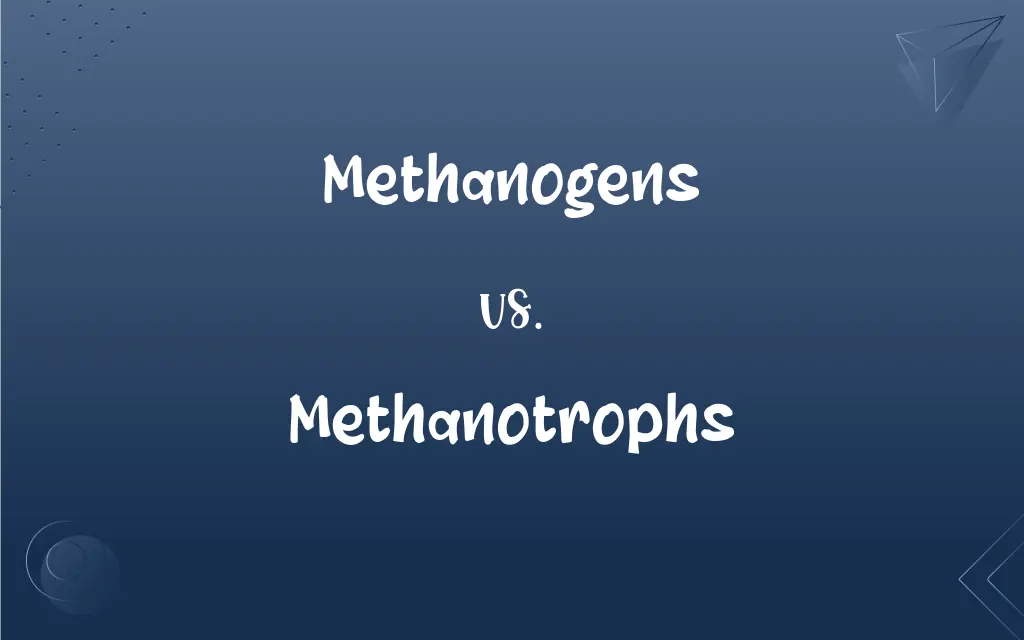Methanogens vs. Methanotrophs: What's the Difference?
Edited by Harlon Moss || By Janet White || Published on February 28, 2024
Methanogens are microorganisms that produce methane as a metabolic byproduct in anoxic conditions, while methanotrophs consume methane as their energy source.

Key Differences
Methanogens are a group of microorganisms that produce methane as part of their metabolism in oxygen-deprived environments. They are a key part of the carbon cycle, converting carbon dioxide and other compounds into methane. Methanotrophs, in contrast, are bacteria that consume methane, using it as both an energy and carbon source. They play a crucial role in reducing methane emissions into the atmosphere, thereby impacting global warming.
Methanogens are typically found in environments such as wetlands, gastrointestinal tracts of ruminants, and in sediments. They are archaea, a distinct domain of life, and thrive in anaerobic conditions. Methanotrophs, on the other hand, are primarily bacteria and are found in soils, sediments, and aquatic environments where methane is present. They require oxygen to oxidize methane, making them aerobic organisms.
The biochemical pathways of methanogens involve the reduction of carbon dioxide and other single-carbon compounds to methane. This process is unique to archaea. Methanotrophs use methane as their primary carbon and energy source, oxidizing it through a series of enzymatic reactions to form methanol, formaldehyde, and eventually carbon dioxide.
Methanogens play an essential role in anaerobic environments by decomposing organic matter and producing biogas, which is a mixture of methane and carbon dioxide. This biogas can be harnessed as a renewable energy source. Methanotrophs, by consuming methane, limit the amount of this potent greenhouse gas released into the atmosphere, thus having a mitigating effect on climate change.
In the context of biotechnology, methanogens are studied for their potential in waste treatment and renewable energy production through anaerobic digestion. Methanotrophs have potential applications in bioremediation, as they can be used to mitigate methane emissions from landfills, coal mines, and other sources.
ADVERTISEMENT
Comparison Chart
Metabolic Process
Produce methane from CO2 and H2 in anaerobic conditions
Consume methane using oxygen
Environment
Anaerobic environments like wetlands, ruminant guts
Aerobic environments with methane presence
Organism Type
Archaea
Bacteria
Role in Carbon Cycle
Convert carbon compounds to methane
Oxidize methane to CO2
Environmental Impact
Methane production contributing to greenhouse gases
Mitigate methane emissions, reducing greenhouse effect
ADVERTISEMENT
Applications
Biogas production, waste treatment
Bioremediation, reducing methane emissions
Biochemical Pathways
Unique to archaea, involves reducing CO2 to methane
Involves oxidizing methane to CO2
Biotechnological Importance
Studied for renewable energy and waste management
Explored for environmental protection and bioremediation
Methanogens and Methanotrophs Definitions
Methanogens
Methanogens play a crucial role in the carbon cycle by converting CO2 to methane.
Methanogens in wetlands contribute significantly to atmospheric methane.
Methanotrophs
Methanotrophs play a critical role in mitigating greenhouse gas emissions.
Methanotrophs are studied for their ability to offset climate change impacts.
Methanogens
Methanogens are archaea that produce methane in anaerobic conditions.
Methanogens in the cow's stomach help in digesting its feed.
Methanotrophs
Methanotrophs have potential applications in bioremediation and environmental protection.
Methanotrophs are being explored for cleaning up methane-contaminated sites.
Methanogens
Methanogens are a key component of the biogas production process.
Biogas plants utilize methanogens to break down organic waste.
Methanotrophs
Methanotrophs oxidize methane, converting it into less harmful substances.
Methanotrophs transform methane into carbon dioxide and water.
Methanogens
Methanogens are exploited in renewable energy production through anaerobic digestion.
Methanogens are essential for the anaerobic digestion process in biogas plants.
Methanotrophs
Methanotrophs are bacteria that consume methane as their energy source.
Methanotrophs in soil help reduce methane emissions into the atmosphere.
Methanogens
Methanogens are unique to the archaea domain and thrive in oxygen-free environments.
Researchers study methanogens to understand life in extreme environments.
Methanotrophs
Methanotrophs are found in environments where methane is present.
Methanotrophs thrive in wetland soils, consuming the methane produced there.
Methanogens
Any of various anaerobic archaea that produce methane as a metabolic byproduct.
Methanotrophs
Plural of methanotroph
Methanogens
Plural of methanogen
FAQs
Can methanogens be used in renewable energy?
Yes, they're used in biogas production through anaerobic digestion.
What are methanogens?
Methanogens are archaea that produce methane in anaerobic conditions.
Where do methanotrophs live?
They live in aerobic environments where methane is present.
Can methanotrophs be used in environmental protection?
Yes, they have potential in bioremediation and reducing methane emissions.
How do methanotrophs affect the environment?
They reduce methane emissions, mitigating the greenhouse effect.
Are methanogens and methanotrophs the same?
No, methanogens produce methane, while methanotrophs consume it.
Do methanotrophs need oxygen?
Yes, methanotrophs require oxygen to oxidize methane.
Where are methanogens found?
Methanogens are found in wetlands, ruminant guts, and anaerobic sediments.
What is the role of methanogens in the carbon cycle?
They convert carbon compounds to methane, affecting the carbon cycle.
Are methanogens harmful to the environment?
Methanogens contribute to greenhouse gas emissions, impacting climate change.
What are methanotrophs?
Methanotrophs are bacteria that consume methane as an energy source.
Can methanotrophs help in climate change mitigation?
Yes, by consuming methane, they can reduce greenhouse gas levels.
Are methanogens a type of bacteria?
No, they are a distinct group within the archaea domain.
Are methanotrophs found in wetlands?
Yes, they are present in wetlands and consume methane produced there.
Do methanotrophs have commercial applications?
Yes, in bioremediation and environmental monitoring.
Are methanogens beneficial for agriculture?
They play a role in organic matter decomposition and biogas production.
How do methanotrophs consume methane?
They oxidize methane, using it as an energy and carbon source.
Do methanogens need oxygen?
No, methanogens thrive in anaerobic (oxygen-free) environments.
How do methanogens produce methane?
They convert CO2 and H2 into methane through metabolic processes.
Can methanogens survive in extreme environments?
Yes, they can thrive in extreme anaerobic environments.
About Author
Written by
Janet WhiteJanet White has been an esteemed writer and blogger for Difference Wiki. Holding a Master's degree in Science and Medical Journalism from the prestigious Boston University, she has consistently demonstrated her expertise and passion for her field. When she's not immersed in her work, Janet relishes her time exercising, delving into a good book, and cherishing moments with friends and family.
Edited by
Harlon MossHarlon is a seasoned quality moderator and accomplished content writer for Difference Wiki. An alumnus of the prestigious University of California, he earned his degree in Computer Science. Leveraging his academic background, Harlon brings a meticulous and informed perspective to his work, ensuring content accuracy and excellence.







































































